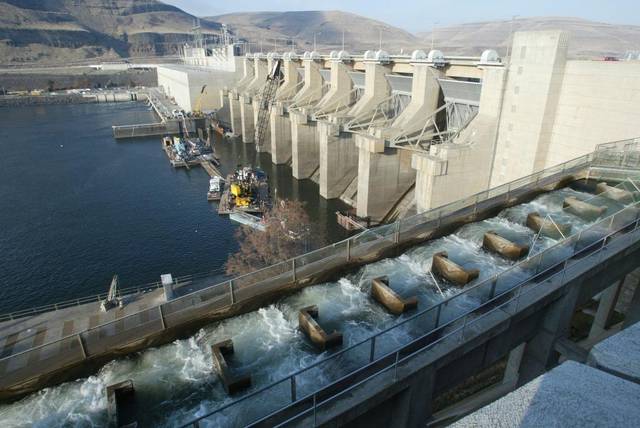forum
library
tutorial
contact

More People Means More Electricity Needs.
Can We Get By Without Hydropower?
by Bill Virgin
The News Tribune, April 20, 2019
|
the film forum library tutorial contact |

|
More People Means More Electricity Needs.
by Bill Virgin
|
One possible solution is renewables combined with utility-scale storage batteries.
 Water -- is there anything it can't do?
Water -- is there anything it can't do?
It can float boats, making long-distance travel and trade possible. It grows our food, then helps cook it (and provides the base for many wonderful beverages to accompany those meals). It cleans our clothes, our homes and ourselves.
It's also a great store of energy, and that fact is going to be increasingly important in the Northwest and globally if we want to continue living with another marvel of modern civilization -- electricity.
The electric utility industry doesn't change fast or often, which is largely to the good; the system is too vital, complex and expensive to tolerate tinkering with it without a compelling reason for doing so.
But change is coming, because increased demand is being placed on the system even as restrictions also are increasing on how that demand is met. Water already plays a critical role, especially in the Northwest, in how demand and supply are balanced. Water will be crucial to maintaining that balance, and at what cost, as a recent bit of news illustrates.
The Chelan County Public Utility District, which operates three hydroelectric dams (two on the Columbia) has signed a power supply agreement with Microsoft. The announcement says the arrangement will give the software company "a zero-carbon headquarters, as Microsoft's Puget Sound operations will be powered entirely by local hydro."
Umm, no it won't.
Unless Microsoft is proposing to build a closed transmission and distribution system isolated from the rest of the region's grid, those nice clean, green, renewable electrons shoved over the mountains will be mixed in with some produced with not-so-lovely sources like coal, natural gas and nuclear.
Electricity doesn't arrive at your home or business labeled with its source. That's not how it works.
Microsoft reputedly has some smart people working for it, so it's likely they understand that. But they also understand finances and branding. What matters is being able to buy what is some of the cheapest wholesale electricity in the nation (the parties involved aren't disclosing the price terms for 50 average megawatts) accompanied with the utility's label of coming from an "all-renewable, carbon-free generation portfolio."
But just how clean and green is hydropower anyway?
Natural gas was an environmentally friendly fuel when it could be used as a cudgel against coal. With coal now in disfavor and plants being idled in the Northwest, the attention is turning to gas. After that, it'll be hydro's turn, as despoiler of the region's wild and scenic rivers, enemy of the salmon and the ruin of native fishing grounds.
The fashion of late is to pull out dams deemed no longer needed. Often these are aging facilities that were built for specific industrial facilities no longer operating. But there's also talk of yanking out dams, like the four on the Lower Snake River, still providing useful work for power generation and river navigation.
What replaces that generation if hydro's contribution begins falling? Try licensing a new hydro project, even a modestly sized one, and watch how blissfully it sails through the regulatory mudflats.
So if no coal, no gas, no hydro (nuclear has its own set of issues), then what?
Renewables, of course, most notably wind and solar. In the same announcement as the Chelan PUD agreement, Microsoft disclosed it's negotiating another supply agreement "that would see the company contract for output of a new wind or solar resource in the state."
Yet that too is an endorsement of hydro or (yikes) gas, coal or nuclear, because some sort of reliable and dispatchable generating source is needed to back up renewables, lest Microsoft's programmers shiver in the dark as they write lines of code in pencil on pads of paper.
We might want to keep those other sources around for another reason: We're asking electricity to do more, especially in the realm of transportation. Cars, boats, planes, trains, all weaned from that Ol' Devil fossil fuel, converted to run on electricity derived from clean, green renewables … and hydro, natural gas, nukes and coal. That's going to take a lot of juice.
So will running all the power-hungry gadgets we have. So will housing, warming, cooling, feeding, equipping and moving all the extra people that come with a growing population.
Where's that going to come from, at a scale and a time that's useful to all those people?
One possible solution is renewables combined with utility-scale storage batteries. That's not a science fiction fantasy. In a decade that could well be a viable model, as battery technology improves and is proven, but it'll take a lot of batteries at no small cost to replace the un-green capacity being removed from the grid.
Water, too, can be made to act like a battery, by using excess power (hydro, wind, solar, whatever) in low-demand periods to pump water uphill to a reservoir, then releasing it when it's needed. There are proposals for such pumped-storage projects kicking around the Northwest, but they're not cheap nor is permitting easy.
The combination of water and gravity has proven a powerful force for doing work and shaping society for centuries. For the Northwest in this new, green age, the question is not whether it can still do those jobs, but whether it will be allowed to.
learn more on topics covered in the film
see the video
read the script
learn the songs
discussion forum
